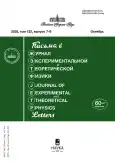Topological invariant responsible for the stability of the Fermi surfaces in non-homogeneous systems
- Autores: Zubkov M.A.1
-
Afiliações:
- Ariel University
- Edição: Volume 122, Nº 7-8 (2025)
- Páginas: 513-515
- Seção: Articles
- URL: https://rjsvd.com/0370-274X/article/view/697141
- DOI: https://doi.org/10.7868/S3034576625100218
- ID: 697141
Citar
Texto integral
Resumo
The topological invariant responsible for the stability of Fermi point/Fermi surface in homogeneous systems is expressed through the one particle Green function, which depends on momentum. It is given by an integral over the 3D hypersurface in momentum space surrounding the Fermi surface. Notion of Fermi surface may be extended to the non-homogeneous systems using Wigner–Weyl calculus. The Fermi surface becomes coordinate dependent, it may be defined as the position of the singularity in momentum space of the Wigner transformed Green function. Then the topological invariant responsible for the stability of this Fermi surface is given by the same expression as for the homogeneous case, in which the Green function is replaced by its Wigner transformation while the ordinary products are replaced by the Moyal products. We illustrate the proposed construction by the examples of the systems, in which the given topological invariant is nontrivial and may be calculated explicitly.
Bibliografia
- T. Matsuyama, Prog. Theor. Phys. 77, 711 (1987).
- G. E. Volovik, The Universe in a Helium Droplet, Clarendon Press, Oxford (2003).
- Z. V. Khaidukov and M. A. Zubkov, Phys. Rev. D 95, 074502 (2017); arXiv:1701.03368.
- M. A. Zubkov and Z. V. Khaidukov, JETP Lett. 106, 166 (2017) [Pis'ma ZhETF 106(3), 166 (2017)].
- M. Suleymanov and M. A. Zubkov, Phys. Rev. D 102, 076019 (2020).
- M. Zubkov and R. A. Abramchuk, Phys. Rev. D 107, 094021 (2023).
- M. Zubkov, J. Phys. Condens. Matter 36, 415501 (2024).
- P. D. Xavier and M. Zubkov, arXiv preprint arXiv:2410.06952.
Arquivos suplementares










